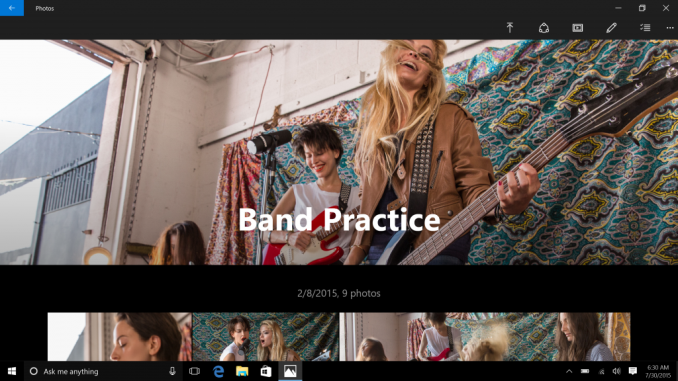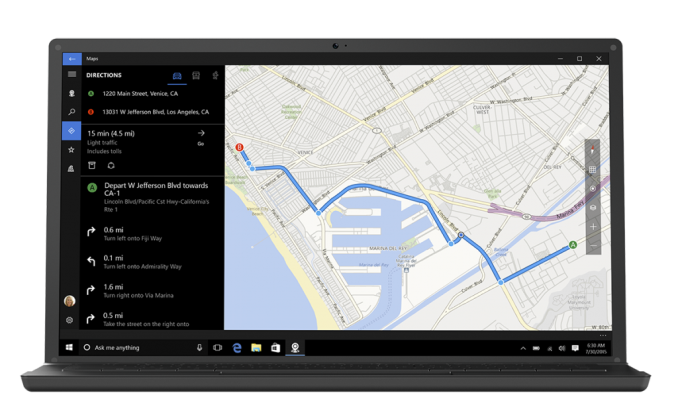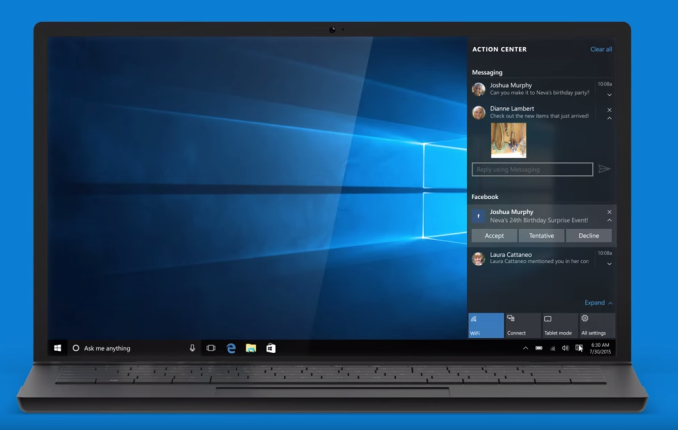The Windows 10 Review: The Old & New Face of Windows
by Brett Howse on August 25, 2015 8:00 AM EST- Posted in
- Operating Systems
- Microsoft
- Windows 10
Photos
Another app that was in desperate need of attention was Photos. The Windows 8 photos app was frankly a nightmare, and it was one of the first things I disabled on any new install. The new version is far superior to what came before, in both looks and functionality.
Once again, we have a Universal Windows App which means that it can scale and reflow to fit any display size or window. By default, it grabs pictures from your pictures folders in your user profile as well as OneDrive, and you can also toggle whether or not to show pictures from OneDrive which are not synced with your PC.
Once in the app, you can browse photos by your collection, which shows all photos, or by albums. Collection is pretty self explanatory, and just contains a list of all photos in chronological order. There is no way to sort any other way, although you can click on a month to jump to another date. The albums view is a lot different though, and the system will automatically create albums based on time and location in your photos, and then present them to you. You can change what photos are in the album if you want to.
The Photos app does some nice things like automatically not displaying duplicate photos, and it can clean up images and remove red-eye in a non-destructive manner. If you don’t like the auto-enhance, it can be turned off.
The Photos app is now the default app for viewing pictures, and it supports most photo and video file types, and they recently added GIF support which is one format that was left out of the previous photos app in Windows 8.
It is a good improvement over the Windows 8 version, and being a Universal Windows App means it supports high DPI and multiple display sizes. I’d like to be able to create my own albums, and that is not possible yet. The change is going to be pretty drastic for those coming from Windows 7 though, and people tend to not like change.
Maps
I’d be curious to see how many people use mapping in an app on the desktop compared to mobile systems. I tend to gravitate to the web on my desktop when I need mapping capabilities. But with Windows 10 going to be deployed on everything from phones to Xbox, having mapping as an app is obviously important.
Microsoft leverages HERE for their mapping technology, and while Nokia recently sold the HERE divisionto a group of automotive companies, the licensing arrangement is likely part of that transfer. Mapping is a very personal experience though, and some people may love HERE maps while others can’t use them because they are missing local information. It’s an incredibly difficult industry to get into and keep up to date. Google is the obvious competitor here, and they have spent a lot of money and time to build up their mapping to the point it is now. HERE has some street view, but none in my area. One thing HERE has been working on though is interior views of places like malls. I’ve used this before on the phone and it is pretty handy although it appears to be missing from the data available right now on Windows 10.
The mapping app itself is fairly well sorted out, and it can easily do directions or searches as you would expect. The views themselves can be either from straight overhead, or you can get a bird’s eye view as well and tilt and pan the camera. On a standard 2D map this can give you a nice sense of direction, but in some locations, the maps have 3D views as well which is a very nice effect. 3D views are only available in select areas, but they are a great way to find your way around when you can use them.
Another great feature of Maps which is built right into Windows 10 is the ability to download and manage offline maps. You can pick your area and have the maps ready to go without having to wait for the lag of your internet connection. It appears to only work with the road maps though and not aerial views which makes sense when you think about how much data you would need to download for aerial views of anywhere larger than a city.
The performance of maps on the devices I have tested it on is very good. Clearly this is all being offloaded to the GPU because the rendering is fast, and rotations and panning is very smooth. Once you get into the 3D maps though it can tax the system quite a bit. I still found performance good even on integrated graphics, but on laptops it is going to create some heat to get rid of since the GPU can draw a lot of power, even on integrated devices.
Maps are good on the desktop, but you can see that this app is one that will be more important on smaller devices running Windows 10, since you’ll be able to have your offline maps available for use on the go.
Messaging
When Windows 10 was shown off in January, one of the apps that was shown was a new messaging app. Windows 8 included both a touch based Skype app, and the traditional full desktop app, but the touch version never seemed to offer as consistent of an experience as the desktop version. For Windows 10, it would be replaced with new standalone apps for messaging, phone, and video.
Windows 10 is now here, but delays in the messaging apps mean that for the moment, people who want to use Microsoft’s messaging service need to use the full desktop version of Skype, since the touch version has been removed from the store for all users except those on Windows RT.
Once the new messaging apps are released, I will check them out and see how well they work. Being based on Skype, the backend is at least well known and Skype itself has improved a lot as a messaging app over the last couple of years.














293 Comments
View All Comments
inighthawki - Tuesday, August 25, 2015 - link
Lol this image is so full of crap. Not only can you turn most of it off permanently (And yes, you can disable WU and WD from the services list and it will not start back up) but this image is so misleading. They even photoshopped an ad in the start menu on a setting that doesn't even exist in the RTM build... Come on, that's low. Mos tof the other things such as "tracking keystrokes and browsing history" for wbe browsing exist in Windows 7 and 8. Wi-Fi sense has been known to be blown way out of proportion. Telemtry has also been proven to only provide non-personal information. It collects stuff such as hardware configurations, statistical information like how often you click the start button, and machine crashes. Does this seriously worry you that Microsoft knows that "someone in the world" owns a MacBook pro and clicked the start button 8 times today?You're really just buying into a bunch of fearmongering by a bunch of people who just wanted excuses to continue using Windows 7. If you don't like Windows 10 or don't want to use it, that's fine, but don't cite these ultra poor excuses as the reasons why, as it shows you didn't actually look much further than the surface, and just jumped on the bandwagon.
Notmyusualid - Tuesday, August 25, 2015 - link
Thank you for your (what I believe is an incorrect opinion), but I HAVE EVERYTHING TURNED OFF, and my firewall logs STILL show encrypted packets going out to Microsoft - EVERYTIME I hit a key, and everytime I open a program.So even if somebody starts with a Microsoft Account, their data would be synced to MS, before many would realise what had happened.
There is absoultely nothing you can say that would make me believe that MS deserves access to my contacts. Those are private.
And no, I did not jump on any bandwagon, I did my own testing, came to similar conslusion as the picture stated, and yes, I will be continuing to use Win 7, as I do not like it.
Only Enterprise Editions can disable all modes of telemetry...
inighthawki - Tuesday, August 25, 2015 - link
Oh OK, so you saw encrypted packets going out... So I guess you decrypted them and looked at the content, then? Sending information when certain types of hardware interrupts occur does not mean they are sending personal information or recording your keystrokes like a keylogger. You have no way of knowing what's in the packets, yet you make assumptions that it's a privacy issue. Yet another example of someone pretending they're fully informed because they open up Wireshark and see some packets being sent over the network and "came to a conclusion" about what was really happening.minijedimaster - Tuesday, August 25, 2015 - link
Are you paid to have some shill answer for everything windows 10? "Oh well, so you proved me wrong with your firewall packet captures, but do you REALLY know what it's sending???"LOL, yeah ok... go be a paid shill somewhere else.
inighthawki - Tuesday, August 25, 2015 - link
Sorry if I'm not irrational/paranoid and don't jump to conclusions based on evidence that doesn't actually show any of the claims you're making.Oh no, a network packet! My entire life must now belong to Microsoft's hands!
SlyNine - Tuesday, August 25, 2015 - link
I have to disagree. Your computer sending encrypted packets to Microsoft, even tho you supposedly disabled that stuff, is a HUGE red flag. At that point its up to Microsoft to convince me that they are NOT sending personal information (it shouldn't be sending any). I might have to pass on windows 10 until this gets clarification.imaheadcase - Wednesday, August 26, 2015 - link
Most modern windows OS send data to MS encrypted, almost all programs with internet connectivity do. The OP is prob just looking at the encrypted data it sends to check for windows updates. Has nothing to do with privacy.Holy hell did everyone just step on the jump to conclusions mat. lol
Notmyusualid - Friday, August 28, 2015 - link
It has everything to do with privacy.Every time I press a key, a packet is sent. This is not updates.
Notmyusualid - Friday, August 28, 2015 - link
It IS a Huge Red Flag.This guy is a Microsoft employee.
nikon133 - Sunday, August 30, 2015 - link
You sound like you might be working for competition, though. Apple? Some shady Linux brotherhood? Just saying.